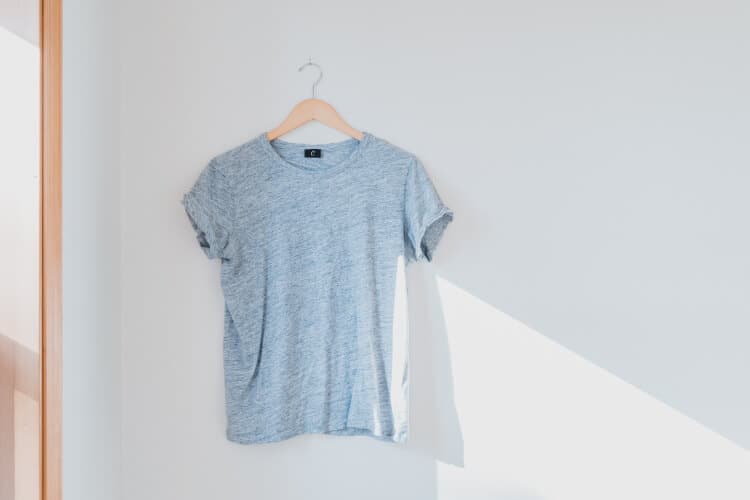We all have at least one or two oversize t-shirts in our wardrobe (most likely a Christmas gift) that we’ve wondered what to do with. They are brand new and too good-looking to be turned into cleaning rags; sending them to the seamstress for a customized adjustment can be a rather expensive mission; and although you are all for donating clothes, these particular garments have the potential to become your favorite shirts – if only they were a size smaller.
The good news is that depending on the fabric the shirt is made of, it is possible to shrink it down to your size with only a handful of materials found in most households. The bad news – or rather the not-so-good news – is that, as a non-professional DIY procedure, shrinking clothes at home is sort of a hit-and-miss.
But before diving into the practice, let’s understand a bit of theory: Why do clothes shrink in the first place?
Why do Clothes Actually Shrink?
The first thing to note is that the vast majority of garments will naturally shrink over time – some are just more susceptible to shrinkage than others or undergo the process faster. Many factories stretch the fabric during the manufacturing process so less material is used when producing a piece, which saves them money.
This process, in turn, makes highly shrink-prone fabrics such as cotton to return to their natural, unprocessed size after being washed, for the water “relaxes” the fibers from the tension applied by the mechanical stretching.
That being said, nowadays many pieces of clothing have been preshrunk, which means the fabric is already in its original size and the fibers are less likely to shrink (or not shrink as much as stretched ones) with one of the following methods.
How to Shrink Clothes at Home
As we’ve mentioned, some fabrics have a higher tendency to shrink than others. So instead of telling you how to shrink a polyester shirt (which, by the way, won’t shrink), we’ll use cotton to exemplify the procedures. Also, we’ll be focusing on the two easiest and least demanding methods equipment-wise – most other techniques involve too much paraphernalia or skills.
How to Shrink a Cotton Shirt With Hot Water
This is the most basic and relatively reliable method to make a shirt smaller in the comfort of your home. Plus, it is the safest when it comes to ensuring it shrinks evenly.
Fill up a big pot with water and bring it to boil. Once the water starts boiling, turn the stove off and dip the shirt in the hot water. Generally, the hotter the water and the longer the shirt is submerged the more it will shrink, but an average of 5 minutes underwater (depending on the shirt’s size) should be enough to work on the fibers.
You can always increase the immersion time if you’re aiming for more shrinkage. Alternatively, wait until the water cools down a bit before plunging the shirt in and the effects shouldn’t be as radical as with when the water has just stopped boiling. Next, remove the wet shirt from the pot and wait until it cools down before handling it. Wring it out and hang it to dry. Then, try it on!
Should you want it to be even smaller, feel free to repeat the process until it fits you (near) perfectly.
How to Shrink Shirts With a Washer/Dryer
Contrary to popular belief, dryers don’t shrink clothes; instead, the shrinking is caused when the material bumps against the walls of the washer and dryer. The movement of the clothes inside the machine also influence how much they will shrink, so machines with frontal doors – which tend to produce less agitation – render less shrinkage than their top-door counterparts.
This method is as simple as putting your shirt to wash in the hottest setting available, then throwing it into the dryer on a warm setting. Remember that you don’t need to burn the shirt in order to shrink it – it is the bouncing off the dryer’s walls what makes it shrink, hence the warm setting. Done? Try it on to see if it fits. Need smaller? Repeat the process.
Besides cotton, the washer/dryer method works well on linen, denim, hemp, and microfiber.
Does Fabric Matter?
Have you ever tried a few different fabric t-shirts one after the other? If so, you will have noticed how they each feel differently on the body. Likewise, when it comes to shrinking garments, every fabric responds differently to the same shrink technique. As a rule of thumb, so-called open fabrics – those which have more space between the yearns – tend to shrink easier than closed fabric.
Below we give you a breakdown on some of the most popular fabrics out there and their particular characteristics in terms of shrink-ability.
Cotton
Despite its difficulty to breathe, natural cotton is generally one of the most recommended fibers to wear. It is also one of the most elastic ones, especially in the case of knit fabrics like sweaters and t-shirts, which tend to shrink more but also spring back to their original shape with more versatility than woven fabrics. Again, it comes down to the space between the yarns: a knit has more open space than a woven, thus is more likely to shrink.
Polyester
If you’ve spent long enough researching about different types of fabrics and how to shrink them you most likely came across the question “Can polyester shrink?” Like his synthetic-brother nylon, polyester is a thermoplastic fabric – a property that makes it hard (or nearly impossible) for it to shrink, or even wrinkle.
Jeans/Denim
When it comes to how to shrink pants – in this case, jeans – one has to be careful and pay attention to the instructions on the label. There are all sorts of cuts and fabric combinations for denim pants, and whereas some may take a bit more effort to be shrunk others, like unwashed cotton jeans, tend to shrink on the first wash. A key guideline is to always use cold water when washing jeans. Meanwhile, the warm setting in your dryer should be enough to shrink it to your size.
Wool
There’s a very high chance that you have shrunk a wool sweater beyond recognition. So with wool, the question is not whether or not it shrinks, but how not to shrink it too much. Because of the way the fiber’s scales mat while in the washer and dryer, it’s often best to warm wash a wool sweater by hand. This way you can manipulate it with care and avoid the overheating or agitation of the machine washing/drying.
Keep in Mind
As with any DIY process, you have to expect imperfections when shrinking clothes at home. Therefore, we thought we’d wrap it up with some key points to look out for before deciding to actually take this road.
- When using the washer/dryer method, the hot setting may make a colored material bleed and stain other light fabrics – so wash them separately.
- Drying clothes in a dryer may affect the color’s vibrancy for the slamming against the walls microscopically enlarges the fibers and gives them an opaque appearance.
- Either don’t shrink stamped garments with method II or if you do so, turn it inside out.
- Imperfections mean that the piece of clothing may shrink unevenly or alter its shape/cut.
- If a label says “Dry clean only” don’t try to shrink it; rather give it to a seamstress.
- Needless to say, once you’ve shrunk a garment, you won’t be able to make it larger again.







